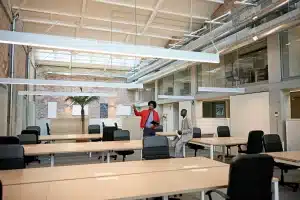/ Why perform such audits?
A building audit, in other words a detailed inventory of fixtures, is a tool with a specific objective. This may be to reassure the lessor as to its future use, to determine the longevity of the building, or to determine what work needs to be undertaken to ensure its proper functioning.
This is known as atechnical audit.
But it can also be a question of knowing its impact on the environment and the reality of its energy consumption.
However, reducing this has become a legal obligation since the publication of the decree relating to the Tertiary Eco-Energy Scheme in 2019, resulting from the ELAN law published in 2014, which sets a 60% reduction in the energy consumption of tertiary parks in 2050, compared with a reference year defined between 2010 and 2019.
That's where theenergy audit comes in.

/ How are audits carried out?
The aim of the technical audit is to ensure that the building is solid, watertight, that its equipment is of good quality and obsolete, that it is durable, and that the people working in it are safe. But also, of course, to verify regulatory compliance. The auditor begins with a visual inspection of the facade, exterior walls, roofing, openings and so on. He then examines the condition of the framework, foundations, cladding, roofing, heating, air-conditioning, ventilation, lighting and plumbing systems. These inspections can be carried out on a preventive or curative basis.
The aim of an energy audit is to provide detailed information on a building's energy consumption, in order to identify the measures to be implemented to reduce it. It therefore includes recommendations constituting an improvement plan, the cost of which is quantified. The conduct of such an audit is governed by European standard EN 16247.
Auditors use two types of simulation to measure heat exchange within a building. Static thermal simulation is based on existing data (composition of heat-dissipating walls, number of occupants, installed lighting power, air renewal rate, power of ventilation equipment, set temperatures for heating and air conditioning, etc.) to estimate consumption and identify possible heat losses (considering independent indoor temperatures over time).
Dynamic thermal simulation uses specific software to estimate a building's heating and cooling requirements, taking into account precise surrounding meteorological data, occupancy scenarios and HVAC predefinitions. It also takes into account changes in indoor temperature over a chosen period of time (a complement to the static version).
It can also be used, for example, to predict future consumption by modifying meteorological data.
/ Sinteo experts /
The urgency of climate change, regulations and rising energy prices mean that the profession of commercial building auditor is at the heart of today's challenges.
Our thermal engineers are trained in-house in our methods. They spend around 20% of their time on a variety of sites with different issues (retail space, hotels, offices, etc.) and then build short- and long-term scenarios.
A recent building with good intrinsic energy performance may have excess consumption.
The challenge is to operate the latter's equipment with an action on regulation.

Presentation of the system for monitoring indoor air quality in ERP buildings
Contents 📖 Indoor Air Quality (IAQ), a public health issue We spend over 80% of our time in enclosed spaces,

Our study on energy consumption in offices - Edition 2024
Guide contents 📖 1. Introduction to the study Faced with the growing challenges of energy efficiency, driven both by new regulations and potential

Complete Guide to CEE BAT-TH-116 for BMS
In the building industry, a BMS is a computerized system for supervising and controlling various technical equipment. It is capable of controlling all

BACS GTB Decree: Comprehensive Guide for Commercial Buildings
The BACS decree was put in place to accelerate the development of control systems (GTB), in order to optimize the

GTB Class A according to NF EN ISO 52120-1-2022
BMS stands for Building Management System. It's an IT solution that's installed in large buildings, such as

BMS and BMS: what are the differences and applications?
With current environmental concerns, energy consumption is at the heart of discussions. As a result, BMS and BMS play an important role in

